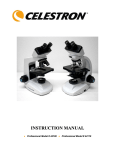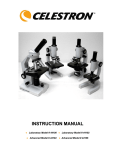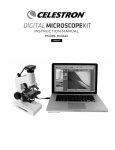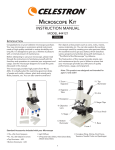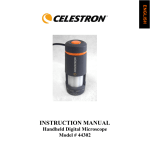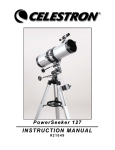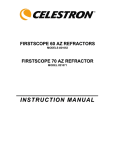Download Celestron 44110 Instruction manual
Transcript
INSTRUCTION MANUAL ● Professional Model # 44108 ● Professional Model # 44110 Table of Contents Care and Maintenance ………………………………………………………………………. 2 Professional Model # 44108 …………………………………………………………………. 3 Professional Model # 44110 …………………………………………………………………. 9 Warranty ……………………………………………………………………………………... 15 Introduction Congratulations on your purchase of a Celestron microscope. Your microscope is a precision optical instrument, made of the highest quality materials to ensure durability and long life. It is designed to give you a lifetime of pleasure with a minimal amount of maintenance. This instruction manual covers two different microscope models. Please be sure to locate your specific model of microscope in order to ensure you read the correct information. Before attempting to use your microscope, please read through the instructions to familiarize yourself with the functions and operations to maximize your enjoyment and usage. See the microscope diagrams to locate the parts discussed in this manual. The microscopes described in this manual provide high powers from 40x up to 1500x. These microscopes types are ideally suited for examining specimen slides of yeasts and molds, cultures, plant and animal parts, fibers, bacteria, etc. Care and Maintenance Your Celestron microscope is a precision optical instrument and should be treated with care at all times. Follow these care and maintenance suggestions and your microscope will need very little maintenance throughout its lifetime. • • • • • • • • • • • • • • When you are done using your microscope, remove any specimens left on the stage. Turn off any electric illuminators. Unplug any power cords being used. Always place the dust cover over the microscope when not in use or when being stored. Store the microscope in a dry and clean place. Be very careful if using your microscope in direct sun light to prevent damage to the microscope or your eyes. When moving your telescope, carry it by the “arm” with one hand and not by the focuser knobs, eyepiece housing, etc. Then, put your other hand under the base for support. Clean the outside surfaces (metal and plastics) with a moist cloth. Always unplug any cords before cleaning. Never clean optical surfaces with cloth or paper towels as they can scratch optical surfaces easily. Blow off dust with a camels hair brush or an air blower from optical surfaces. To clean fingerprints off of optical surfaces, use a lens cleaning agent and lens tissue available at most photo outlets and when cleaning do not rub in circles as this may cause sleeks or scratches to occur. Never disassemble or clean internal optical surfaces. This should be done by qualified technicians at the factory or other authorized repair facilities. When handling glass specimen slides, be careful as the edges can be sharp. 2 Professional Microscope – Model 44108 1. Head 2. Nosepiece 3. Objective 4. Specimen Stage 9. Stage Holder Clamp 5. Iris Diaphragm 8. Stage Movement Knobs 6. Illuminator 7. Coarse Focus Knob Figure 1 Top & Bottom 18. Eyepiece 10. Locking Screw 17. Eyepiece Holder & Diopter 11. Arm 12. Tension Adjustment Ring 16. Iris Lever 13. Fine Focus Knob 15. Base 14. On/Off Switch 3 Standard Accessories Included with your Microscope • • • • • • • • • • • • • Two 10x Eyepieces Two 15x Eyepieces 4x Objective Lens 10x Objective Lens 40x Objective Lens 100x Objective Lens Electric Illuminator Red, Blue, Green Color Filters AC Adapter Immersion Oil 5 Prepared Slides Dust Cover Extra Halogen Bulb 12V-15W Specifications Model # 44108 Stage Head Focuser Objectives Eyepieces Interpupilliary Distance Nosepiece Illuminator Condenser Diaphragm AC Adapter Specifications Mechanical Stage 132mm x 140mm 45° Inclined Binocular Head -- 360° Rotatable Coaxial with Coarse and Fine Focus Achromatic 4x, 10x, 40x, and 100x DIN 195mm (2) 10x Wide Field -- 18mm Field of View (2) 15x Wide Field -- 13mm Field of View Adjustable from 55mm to 75mm Quadruple with click stop Built-in electric -- Halogen bulb 12Volt-15Watt Abbe N.A. 1.25 Iris 115Volt-60Hz or Model with 230Volt-50Hz 12VDC-1500ma Magnification (Power) Table Use the following table to determine the magnification of the different eyepiece/objective lens combination of your microscope. Objective Lens 4x 10x 40x 100x 10x Eyepieces 40x 60x 100x 150x 400x 600x 1000x 1500x 15x Eyepieces 4 Setting Up Your Microscope 1. 2. 3. 4. 5. 6. 7. 8. 9. Take the Styrofoam container out of the cardboard carton. Remove the tape from the Styrofoam container holding the two sections together. Carefully remove the microscope and other parts from the container and set them on a table, desk, or other flat surface. Remove the plastic bag covering the microscope. Remove the plastic caps from the eyepiece holders (17) on the binocular head. Insert the two 10x eyepieces in the eyepiece holders (17). They are held in place by a friction fit. Remove the four objective lenses (3) from their containers. Unscrew the container lids from the threaded portion of the objective lenses. Thread the end of the 4mm objective lens into one of the holes on the nosepiece (2) until finger tight. It may be necessary to lower the stage (4) by turning the coarse focus knob (7). Now turn the nosepiece to the next opening and thread each of the remaining objective lenses into the remaining holes. Socket AC Adapter Figure 1a 10. Plug the small cable from the AC adapter into the socket on the back of the base (see Figure 1a). 11. Insert the plug end of the AC adapter into the proper power source. Make sure you have the correct AC adapter – some models are 115-volt AC and other models are 230-volt AC You are now ready to use your microscope! Microscope Operation Rotating the Head The head of your microscope can be rotated 360°. Therefore you can view from any position by just moving the head (1) to the desired location. Loosen the locking screw (10) located between the head (1) and the nosepiece (2) on the arm (11). Then, rotate the head (1) to the desired viewing location and then tighten the locking screw (10). 5 Illumination Power Turn the On/Off Switch (14) “On” and adjust the brightness to the level you want. Viewing a Specimen Your instrument is provided with a mechanical stage with a stage holder clamp and directional knobs –see figure 1b and 1c. 1. Use the clamp lever to open the clamping arm of the stage holder clamp (9). 2. Place a specimen slide (3” size) inside the holder and gently close the clamping arm against the slide. 3. Use the stage movement knobs (see Figure 1c) to position the specimen over the opening in the stage (4). The top stage movement knob moves the X axis (forward and backward) whereas the bottom stage movement knob moves the Y axis (side to side). Note: A vernier scale on both axes allows the exact marking and replication of an object in the field of view that the user may want to come back to. Abbe Condenser Stage Movement Knobs Iris Diaphragm Figure 1b Figure 1c Tip: To position the specimen directly under the objective lens, close the opening on the iris diaphragm (see Figure 1b) until it is almost completely closed. You should see a small beam of light projected onto the specimen slide. Now simply use the stage movement knobs (1c) to move the specimen directly inside the beam of light. To achieve the best focus with your microscope, not only can you make adjustments with the coarse and fine focus knobs, but you can also adjust the focus of each eyepiece (diopter adjustment (17) individually (your eyes are slightly different from each other) as well as the interpupillary distance (distance between the center of your eyes). To achieve the sharpest focus – see Figure 1d and: Figure 1d 6 4. First, rotate each eyepiece diopter clockwise so that they are all the way down. 5. Change the distance between the eyepieces by sliding the eyepiece slide plate in or out horizontally. To adjust the slide plate, grasp the knurled portion on each side of the plate. Do not hold the eyepieces to adjust the interpupillary distance. 6. With the 4x objective lens focus with one eye using the coarse and fine focus knobs. 7. Adjust the eyepiece side plate until the whole field of view can be observed through both eyes at the same time without having to 8. move your head side to side. 9. Now read the number off of the eyepiece sliding plate scale. This is your interpupillary distance. 10. Depending on your individual eyes, you may need to make slight adjustments to the right and left eyepieces for the most comfortable viewing. Move the diopter up or down until you have the specimen slide in sharp and comfortable focus. 11. You have started with the 4x objective (which is the lowest power objective) and work your way up to higher powers. 12. Look through the eyepiece while turning the coarse focus knob (7) until the specimen comes into view. You may need to adjust the stage knobs (Figure 1c) slightly to center the specimen in the field of view. Warning: When focusing, be careful not to raise the specimen stage so high that the specimen slide touches the objective lens. Not only can you break your slide but you may scratch the objective lens. 13. Finally, adjust the fine focus knob (13) until you reach the sharpest focus for your eye. Tip: When viewing a specimen with the 100x objective lens, you can improve the resolving power by placing a small drop of immersion oil between the specimen and objective lens. For specimen slides that you prepare yourself, always cover the specimen with a thin piece of glass and place the oil on the cover glass. Do not put the oil directly on the specimen sample. Adjusting the Focus (Figure 1e) Tension Adjustment Ring The tension of the coarse focus knob can be adjusted to be tighter or looser for your particular needs by moving the tension ring clockwise or counterclockwise – see Figure 1e. Adjusting the Focus Stop Rack & Pinion Screw Limit Stop Knob Figure 1f 7 To change the range of working distance of the stage (4) you need to adjust the limit stop knob. Unlock the limit stop knob by pushing it counterclockwise. Move the stage upward or downward to the desired position. Then lock the limit-stop knob by turning it clockwise– see Figure 1f. You will adjust the limit stop knob to prevent an objective lens from hitting the specimen you are viewing. Adjusting the Lighting Specimens of different size, thickness, and color variations will require different levels of illumination. There are three ways to change the amount of illumination when viewing a specimen; adjusting the brightness control on the on/off switch (14), adjusting the Abbe condenser (Figure 1b) and adjusting the iris diaphragm (see Figure 1b): 1. When viewing a specimen that is not transparent or dark in color you may need to increase the amount of light to resolve certain features or details. This is best done by simply increasing the brightness of the illuminator by rotating the brightness control on the on/off switch (14) all the way to its highest setting. 2. When viewing with lower power (4x and 10x) objective lenses you will need to lower the condenser lens in order to spread the light over the larger field of view. To change the position of the condenser, simply rotate the silver center portion of the Iris diaphragm (1b) clockwise until the beam of light spreads wide enough to illuminate the entire field of view when viewing. 3. As you lower the condenser to spread out the light or change to a higher power objective lens, your image will appear dimmer. Instead of increasing the light intensity of the illuminator (which may “wash out” fine detail of the specimen you are viewing), open the aperture of the iris diaphragm to let in more light. Opening and closing the diaphragm (with its lever) will give a relief view of the specimen and allow you to change the depth of field of the specimen being viewed. Using Filters To bring out different levels of detail, experiment with changing the color of the back lighting of the specimen. To change the lighting color, place the blue filter, the green filter, or the yellow filter into the filter holder which is on the bottom of the iris diaphragm. Push the small lever on the bottom part of the iris diaphragm counterclockwise and you will be able to see the holder. Drop a filter into the holder and rotate the filter holder back under the iris. You may need to refocus by adjusting the fine focus knob (13) slightly for best viewing. You should experiment with each of the colors to see the results. See Figure 1g. Filter Holder Figure 1g Replacing the Illuminator Bulb 1. 2. 3. 4. 5. 6. Make sure the power is off and then carefully lay the microscope on one side. On the bottom of the microscope, locate and unlock (counterclockwise) the knurled knob that holds the bulb compartment. See figure 1h. Remove the knurled knob with the bulb and bulb socket. See Figure 1i. Remove the old bulb from its socket but make sure beforehand that the bulb has cooled down before touching it. Install the new bulb by pressing the prongs lightly into the socket. Replace the bulb and bulb holder back into the base (15) by lining up the tabs and then turn clockwise to lock the knob. Figure 1h Figure 1i 8 Professional Microscope – Model # 44110 1. Head 2. Nosepiece 3. Objective 9. Stage Holder Clamp 4. Specimen Stage 8. Condenser Regulator Knob 5. Iris Diaphragm 7. Coarse Focus Knob 6. Illuminator Figure 2 Top & Bottom Images 18. Eyepiece 10. Locking Screw 17. Eyepiece Holder & Diopter 11. Arm 12. Tension Adjustment Ring 16. Condenser Adjustment Screws 13. Fine Focus Knob 14. On/Off Switch 15. Base 9 Standard Accessories Included with your Microscope • • • • • • Two Plan 10x Eyepieces Two Plan 15x Eyepieces Plan 4x Objective Lens Plan 10x Objective Lens Plan 40x Objective Lens Plan 100x Objective Lens • • • • • • Electric Illuminator Red, Blue, Green, White Color Filters Power Cord Immersion Oil 5 Prepared Slides Dust Cover Specifications Model # 44110 Stage Specifications Mechanical Stage 132mm x 140mm Head Focuser Objectives Eyepieces 45° Inclined Binocular Head -- 360°Rotatable Coaxial with Coarse and Fine Focus Plan Achromatic 4x, 10x, 40x, and 100x -- DIN 195mm (2) Plan 10x Wide Field -- 18mm Field of View (2) Plan 15x Wide Field -- 13mm Field of View Adjustable from 55mm to 75mm Reversed Quadruple with click stop Built-in electric Koehler System -- Halogen bulb 6Volt-20Watt Achromatic Swing N.A. 1.2 Deluxe Iris Universal 90volt to 240Volt -- 50/60 Hz Interpupilliary Distance Nosepiece Illuminator Condenser Diaphragm Power Magnification (Power) Table Use the following table to determine the magnification of the different eyepiece/objective lens combination of your microscope. Objective Lens 4x 10x 40x 100x 10x Eyepieces 40x 60x 100x 150x 400x 600x 1000x 1500x 15x Eyepieces 10 Setting Up Your Microscope 1. 2. 3. 4. 5. 6. 7. 8. 9. Take the Styrofoam container out of the cardboard carton. Remove the tape from the Styrofoam container holding the two sections together. Carefully remove the microscope and other parts from the container and set them on a table, desk, or other flat surface. Remove the plastic bag covering the microscope. Remove the plastic caps from the eyepiece holders (17) on the binocular head. Insert the two 10x eyepieces in the eyepiece holders (17). They are held in place by a friction fit. Remove the four objective lenses (3) from their containers. Unscrew the container lids from the threaded portion of the objective lenses. Thread the end of the 4mm objective lens into one of the holes on the nosepiece (2) until finger tight. It may be necessary to lower the stage (4) by turning the coarse focus knob (7). Now turn the nosepiece to the next opening and thread each of the remaining objective lenses into the remaining holes. Figure 2a 10. Plug the power cord into the socket on the back of the base (see Figure 2a). 11. Insert the prong end of the power cord into the proper power source. The electronics in this microscope work anywhere in the world with its universal voltage of 90volt to 240volt. You are now ready to use your microscope! Microscope Operation Rotating the Head The head of your microscope can be rotated 360°. Therefore you can view from any position by just moving the head (1) to the desired location. Loosen the locking screw (10) located between the head (1) and the nosepiece (2) on the arm (11). Then, rotate the head (1) to the desired viewing location and then tighten the locking screw (10) 11 Illumination Power Turn the On/Off Switch (14) “On” and adjust the brightness to the level you want. Viewing a Specimen Your instrument is provided with a mechanical stage with a stage holder clamp and directional knobs. 1. Use the clamp lever to open the clamping arm of the stage holder clamp (9). 2. Place a specimen slide (3” size) inside the holder and gently close the clamping arm against the slide 3. Use the stage movement knobs (see bottom right of Figure 2b) to position the specimen over the opening in the stage (4). The top stage movement knob moves the X axis (forward and backward) whereas the bottom stage movement knob moves the Y axis (side to side). Note: A vernier scale on both axes allows the exact marking and replication of an object in the field of view that the user may want to come back to. Swing Condenser in the center of stage Stage Movement Knob on the right side Figure 2b Tip: To position the specimen directly under the objective lens, close the opening on the illuminator by turning it counterclockwise until it is almost completely closed. You should see a small beam of light projected onto the specimen slide. Now simply use the stage movement knobs (2b) to move the specimen directly inside the beam of light. To achieve the best focus with your microscope, not only can you make adjustments with the coarse and fine focus knobs, but you can also adjust the focus of each eyepiece (diopter adjustment (17) individually (your eyes are slightly different from each other) as well as the interpupillary distance (distance between the center of your eyes). To achieve the sharpest focus – see Figure 2c and: Figure 2c 4. First rotate each eyepiece diopter clockwise so that they are all the way down. 5. Change the distance between the eyepieces by sliding the eyepiece slide plate in or out horizontally. To adjust the slide plate, grasp the knurled portion on each side of the plate. Do not hold the eyepieces to adjust the interpupillary distance. 6. With the 4x objective lens focus with one eye using the coarse and fine focus knobs. 7. Adjust the eyepiece side plate until the whole field of view can be observed through both eyes at the same time without having to move your head side to side. 8. Now read the number off of the eyepiece sliding plate scale. This is your interpupillary distance. 9. Depending on your individual eyes, you may need to make slight adjustments to the right and left eyepieces for the most comfortable viewing. Move the diopter up or down until you have the specimen slide in sharp and comfortable focus. 10. You have started with the 4x objective (which is the lowest power) and work your way up to higher powers. 11. Look through the eyepiece while turning the coarse focus knob (7) until the specimen comes into view. You may need to adjust the stage knobs (Figure 2b) slightly to center the specimen in the field of view. Warning: When focusing, be careful not to raise the specimen stage so high that the specimen slide touches the objective lens. Not only can you break your slide but you may scratch the objective lens. 12. Finally, adjust the fine focus knob (13) until you reach the sharpest focus for your eye. 12 Tip: When viewing a specimen with the 100x objective lens, you can improve the resolving power by placing a small drop of immersion oil between the specimen and objective lens. For specimen slides that you prepare yourself, always cover the specimen with a thin piece of glass and place the oil on the cover glass. Do not put the oil directly on the specimen sample. Adjusting the Focus The tension of the coarse focus knob can be adjusted to be tighter or looser for your particular needs by moving the tension ring clockwise or counterclockwise – see Figure 2d. Tension Adjustment Ring Figure 2d Adjusting the Focus Stop Rack & PinionScrew Limit Stop Knob Figure 2e To change the range of working distance of the stage (4) you need to adjust the limit stop knob. Unlock the limit stop knob by pushing it counterclockwise. Move the stage upward or downward to the desired position. Then lock the limit-stop knob by turning it clockwise– see Figure 2e. You will adjust the limit stop knob to prevent an objective lens from hitting the specimen you are viewing. Using Filters To bring out different levels of detail, experiment with changing the color of the back lighting of the specimen. To change the lighting color, place the blue filter, the green filter, yellow or white filter in the light path by placing one on top of the illuminator (it will drop in place). You may need to refocus by adjusting the fine focus knob (13) slightly for best viewing. You should experiment with each of the colors to see the results. Adjusting the Lighting Specimens of different size, thickness, and color variations will require different levels of illumination. There are three ways to change the amount of illumination when viewing a specimen; adjusting the brightness control on the on/off switch (14) or the illuminator (6), adjusting the Swing condenser (Figure 2b), and adjusting the iris diaphragm (5). 13 1. When viewing a specimen that is not transparent or dark in color you may need to increase the amount of light to resolve certain features or details. This is best done by simply increasing the brightness of the illuminator by rotating the brightness control on the on/off switch (14) all the way to its highest setting or rotate the illuminator in the clockwise direction. 2. When viewing with lower power (4x and 10x) objective lenses you will need to lower the condenser lens in order to spread the light over the larger field of view. To change the position of the condenser, simply rotate the condenser regulator knob (8) clockwise until the beam of light spreads wide enough to illuminate the entire field of view when viewing. 3. As you lower the condenser to spread out the light or change to a higher power objective lens, your image will appear dimmer. Instead of increasing the light intensity of the illuminator (which may “wash out” fine detail of the specimen you are viewing), open the aperture of the iris diaphragm to let in more light. Opening and closing the diaphragm (with its knurled ring) will give a relief view of the specimen and allow you to change the depth of field of the specimen being viewed. The iris diaphragm knurled ring (see Figure 2f) has a scale with an indicator showing what the N.A. of the diaphragm is. Figure 2f Swing Condenser Iris Scale Condenser Adjustment Centering Screws Illuminator 4. 5. 6. 7. For low powers (4x and 10x objectives), you should keep the swing condenser (see Figure 2f) in the light path. However, for higher powers (40x and 100x objectives), you can turn the condenser knob clockwise to move it out of the light path. Use the condenser adjustment centering screws (see Figure 2f) to put the specimen image in the center of the field of view. When the shadow around the field of view of the eyepiece is symmetrical, it shows the condenser has been centered correctly. In fact, you can enlarge the field diaphragm and make the image tangent to the field of view. You can adjust the field diaphragm to prevent extraneous light from entering the light path and this limits the diameter of the light beam entering the condenser. When the image of the diaphragm is just on the edge of the field of view, you can obtain the clearest image. The iris scale can be used to help obtain the best resolution and contrast. You will try to match as best you can the N.A. of illumination with the N.A. of the objective being used. Normally you would put the N.A. of the condenser to 80% of the objective N.A. For example, the 40x objective has an N.A. of 0.65 which would indicate that you would set the scale on the iris diaphragm to 0.52 (0.65 x 0.80 = 0.52). Replacing the Illuminator Bulb and Fuses 1. 2. 3. 4. 5. 6. 7. Make sure the power is off and carefully lay the microscope on one side. On the bottom of the microscope, locate and unlock (counter clockwise) the knurled knob that holds the bulb compartment. See figure 1h. Remove the knurled knob with the bulb and bulb socket. See Figure 2g. Remove the old bulb from its socket but make sure beforehand that the bulb has cooled down before touching it. Install the new bulb by pressing the prongs lightly into the socket. Replace the bulb and its holder back into the base (15) by lining up the tabs and turning clockwise to lock. Two fuses are located in the back of the microscope (see Figure 2a). They are 15A T3 fuses. If the power does not come on, it is possible that one or both fuses needs to be replaced. Make sure all power the power is off and then use a flat head screwdriver to remove the fuses. If they are blown out, replace them with new fuses and then install the fuse box back in place. Figure 2g 14 Celestron Two Year Warranty A. Celestron warrants this microscope to be free from defects in materials and workmanship for two years. Celestron will repair or replace such product or part thereof which, upon inspection by Celestron, is found to be defective in materials or workmanship. As a condition to the obligation of Celestron to repair or replace such product, the product must be returned to Celestron together with proof-of-purchase satisfactory to Celestron. B. The Proper Return Authorization Number must be obtained from Celestron in advance of return. Call Celestron at (310) 328-9560 to receive the number to be displayed on the outside of your shipping container. All returns must be accompanied by a written statement setting forth the name, address, and daytime telephone number of the owner, together with a brief description of any claimed defects. Parts or product for which replacement is made shall become the property of Celestron. The customer shall be responsible for all costs of transportation and insurance, both to and from the factory of Celestron, and shall be required to prepay such costs. Celestron shall use reasonable efforts to repair or replace any microscope covered by this warranty within thirty days of receipt. In the event repair or replacement shall require more than thirty days, Celestron shall notify the customer accordingly. Celestron reserves the right to replace any product which has been discontinued from its product line with a new product of comparable value and function. This warranty shall be void and of no force of effect in the event a covered product has been modified in design or function, or subjected to abuse, misuse, mishandling or unauthorized repair. Further, product malfunction or deterioration due to normal wear is not covered by this warranty. CELESTRON DISCLAIMS ANY WARRANTIES, EXPRESS OR IMPLIED, WHETHER OF MERCHANTABILITY OF FITNESS FOR A PARTICULAR USE, EXCEPT AS EXPRESSLY SET FORTH HEREIN. THE SOLE OBLIGATION OF CELESTRON UNDER THIS LIMITED WARRANTY SHALL BE TO REPAIR OR REPLACE THE COVERED PRODUCT, IN ACCORDANCE WITH THE TERMS SET FORTH HEREIN. CELESTRON EXPRESSLY DISCLAIMS ANY LOST PROFITS, GENERAL, SPECIAL, INDIRECT OR CONSEQUENTIAL DAMAGES WHICH MAY RESULT FROM BREACH OF ANY WARRANTY, OR ARISING OUT OF THE USE OR INABILITY TO USE ANY CELESTRON PRODUCT. ANY WARRANTIES WHICH ARE IMPLIED AND WHICH CANNOT BE DISCLAIMED SHALL BE LIMITED IN DURATION TO A TERM OF TWO YEARS FROM THE DATE OF ORIGINAL RETAIL PURCHASE. Some states do not allow the exclusion or limitation of incidental or consequential damages or limitation on how long an implied warranty lasts, so the above limitations and exclusions may not apply to you. This warranty gives you specific legal rights, and you may also have other rights which vary from state to state. Celestron reserves the right to modify or discontinue, without prior notice to you, any model or style microscope. If warranty problems arise, or if you need assistance in using your microscope contact: Celestron Technical Support Department 2835 Columbia Street Torrance, CA 90503 U.S.A. Tel. (310) 328-9560 Fax. (310) 212-5835 www.celestron.com Monday-Friday 8AM-4PM PST This warranty supersedes all other product warranties. NOTE: This warranty is valid to U.S.A. and Canadian customers who have purchased this product from an Authorized Celestron Dealer in the U.S.A. or Canada. Warranty outside the U.S.A. and Canada is valid only to customers who purchased from a Celestron Distributor or Authorized Celestron Dealer in the specific country and please contact them for any warranty service. 15 Celestron 2835 Columbia Street Torrance, Ca 90503 U.S.A. Tel. 310-328-9560 Fax. 310-212-5835 Web www.celestron.com Copyright 2007 All rights reserved Products or instructions may change without notice or obligation. Printed in China $ 10.00 04-07
















